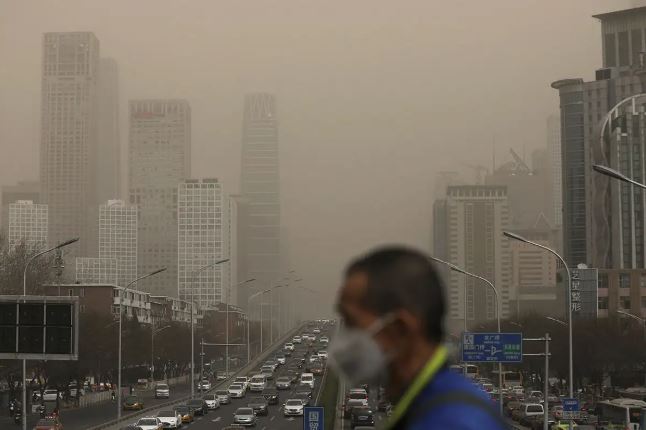


 2:22:6
2:22:6  2025-10-21
2025-10-21  464
464

A common industrial solvent still polluting U.S. air and soil may raise Parkinson’s risk. The findings add to growing evidence that long-term exposure to environmental toxins can affect brain health.
Highlights:
Industrial Solvent TCE and Parkinson’s Risk
Long-term exposure to the industrial solvent trichloroethylene (TCE) in outdoor air may be linked to a higher likelihood of developing Parkinson’s disease, according to a nationwide study published on October 1, 2025, in Neurology, the journal of the American Academy of Neurology.
TCE is commonly used for cleaning metals, dry cleaning, and other industrial tasks. While some uses have been banned, the chemical is still found in modern industry and continues to contaminate air, water, and soil across the United States. The research did not prove that TCE directly causes Parkinson’s disease, but identified a clear association between exposure and risk.
Nationwide Data Reveals a Connection
“In this nationwide study of older adults, long-term exposure to trichloroethylene in outdoor air was associated with a small but measurable increase in Parkinson’s risk,” said study author Brittany Krzyzanowski, PhD, of Barrow Neurological Institute in Phoenix. “These findings add to a growing body of evidence that environmental exposures may contribute to Parkinson’s disease.”
To conduct the analysis, researchers reviewed Medicare data to identify individuals over age 67 who were newly diagnosed with Parkinson’s between 2016 and 2018. Each case was matched with five people of similar demographics who did not have the disease. After removing those without complete ZIP+4 location information, the study included 221,789 individuals with Parkinson’s and more than 1.1 million without the condition.
Mapping TCE Exposure Across the U.S.
They mapped exposure to outdoor TCE concentrations using U.S. Environmental Protection Agency data and participants’ residential neighborhood based on their ZIP +4 location. Air levels of TCE were estimated by U.S. Census tract, a small area within a county. Each participant’s exposure was based on their neighborhood two years prior to diagnosis.
Researchers divided participants into 10 groups based on their estimated TCE exposure. Those in the lowest exposure group experienced levels between 0.005 and 0.01 micrograms per cubic meter (μg/m³), while those in the highest group had exposures ranging from 0.14 to 8.66 μg/m³.
After adjusting for other factors that could affect the risk of Parkinson’s, including age, smoking history and exposure to fine particulate air pollution, researchers found people exposed to the highest outdoor TCE levels had a 10% increased risk of Parkinson’s disease compared to people exposed to the lowest levels.
Geographic Hot Spots and Facility Impact
The researchers also identified several geographic “hot spots” where outdoor TCE levels were highest, particularly in the Rust Belt region of the U.S. and smaller pockets across the country. They then analyzed Parkinson’s risk in the 10 miles surrounding the three top TCE-emitting facilities in the U.S. from 2002. For two of the areas, risk was higher closer to the facilities, and at one of those sites, there was a clear increasing incremental risk the closer people lived to the facility.
Public Health Implications and Limitations
“While the increased risk was modest, the sheer number of people exposed to TCE in the environment means the potential public health impact could be substantial,” said Krzyzanowski. “This underscores the need for stronger regulations and more monitoring of industrial pollutants.”
A limitation of the study is that it focused only on Medicare-aged individuals, so findings may not apply to younger people or those with early-onset Parkinson’s disease. In addition, TCE exposure estimates were based on outdoor air levels in 2002 and may not reflect individual lifetime or indoor exposures.
Reality Of Islam |
|

For years,

New scienti

This is the

A computer
 9:3:43
9:3:43
 2018-11-05
2018-11-05
10 benefits of Marriage in Islam
 7:5:22
7:5:22
 2019-04-08
2019-04-08
benefits of reciting surat yunus, hud &
 9:45:7
9:45:7
 2018-12-24
2018-12-24
advantages & disadvantages of divorce
 11:35:12
11:35:12
 2018-06-10
2018-06-10
 6:0:51
6:0:51
 2018-10-16
2018-10-16
 4:25:57
4:25:57
 2023-02-11
2023-02-11
 7:26:19
7:26:19
 2022-04-08
2022-04-08
 2:34:48
2:34:48
 2022-01-18
2022-01-18
 8:15:37
8:15:37
 2023-02-16
2023-02-16
 2:42:26
2:42:26
 2023-02-02
2023-02-02
 2:5:14
2:5:14
 2023-01-28
2023-01-28
 11:34:48
11:34:48
 2022-06-29
2022-06-29
 5:41:46
5:41:46
 2023-03-18
2023-03-18
| LATEST |